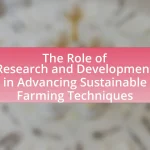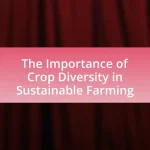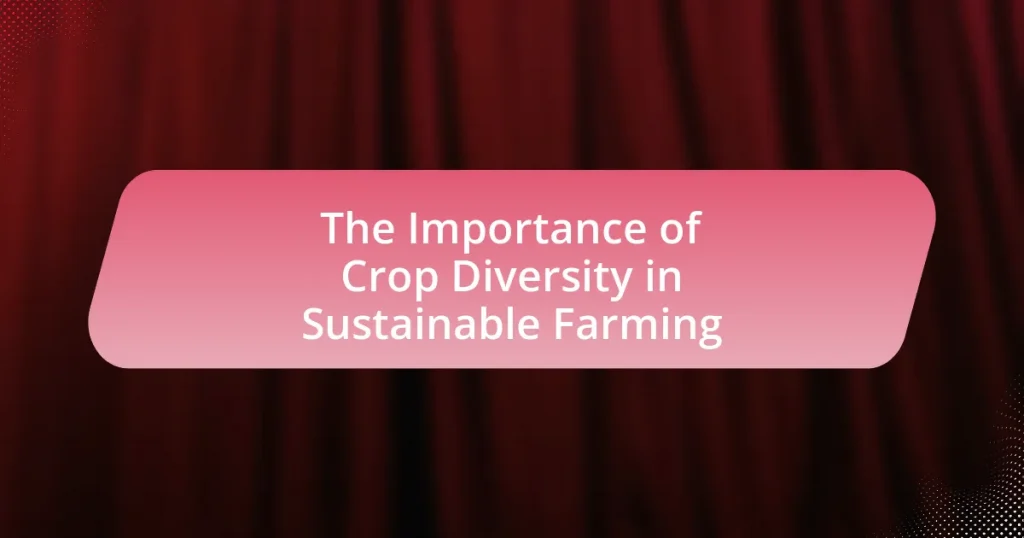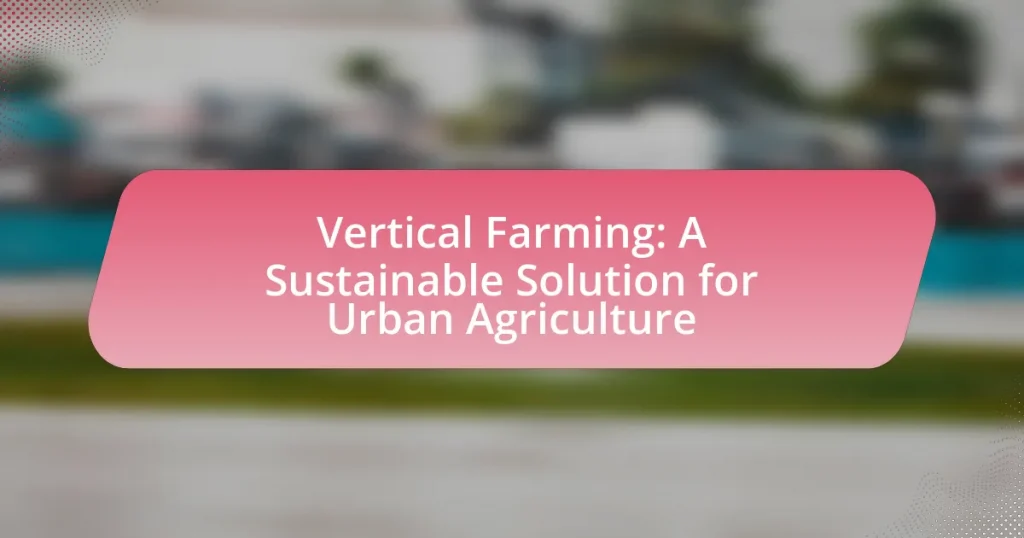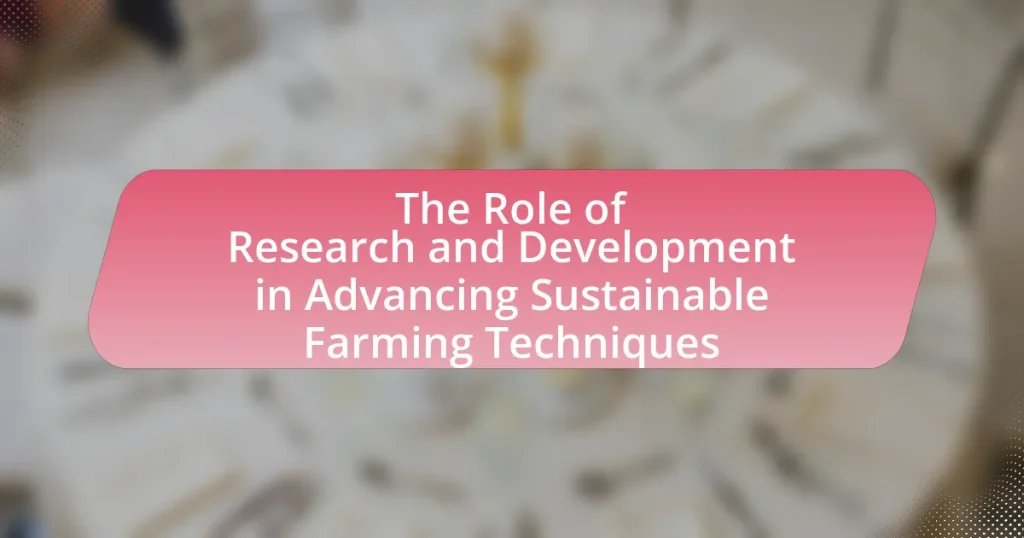Crop diversity is a fundamental aspect of sustainable farming, significantly enhancing ecosystem resilience, soil health, and agricultural productivity. This article examines the critical role of crop diversity in improving food security, mitigating pest and disease outbreaks, and adapting to climate change. It highlights the ecological benefits of diverse cropping systems, including increased yields and improved soil quality, while also addressing the challenges posed by monoculture practices. Additionally, the article discusses practical strategies for farmers to implement crop diversity, such as crop rotation and intercropping, and emphasizes the importance of indigenous crops in promoting local biodiversity and economic resilience.
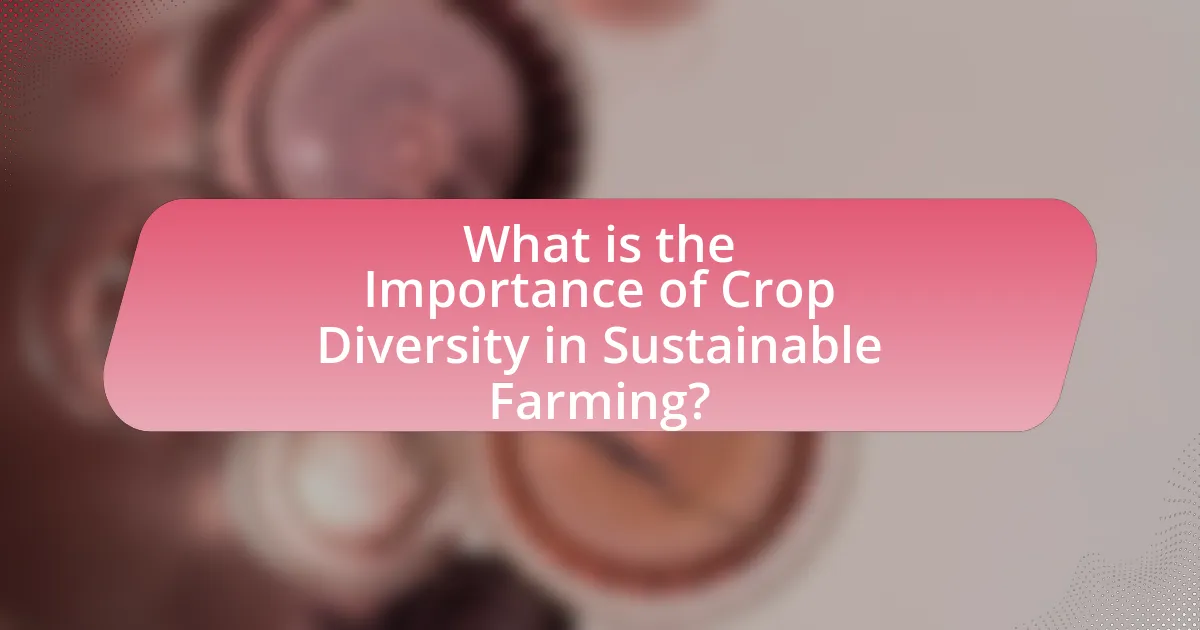
What is the Importance of Crop Diversity in Sustainable Farming?
Crop diversity is crucial in sustainable farming as it enhances ecosystem resilience, improves soil health, and increases agricultural productivity. Diverse crops can better withstand pests, diseases, and climate variability, reducing the need for chemical inputs and promoting natural pest control. Research indicates that farms with higher crop diversity can yield up to 20% more than monoculture systems, as diverse plant species can utilize resources more efficiently and support a wider range of beneficial organisms. Additionally, crop diversity contributes to food security by providing a variety of nutrients and reducing the risk of crop failure, thereby ensuring a stable food supply.
Why is crop diversity essential for sustainable agriculture?
Crop diversity is essential for sustainable agriculture because it enhances ecosystem resilience, improves soil health, and increases food security. Diverse crops can better withstand pests, diseases, and climate variability, reducing the need for chemical inputs and promoting natural pest control. For instance, a study published in the journal “Nature” found that farms with higher crop diversity had 20% higher yields and were more resilient to extreme weather events compared to monoculture systems. This evidence underscores the critical role of crop diversity in maintaining sustainable agricultural practices.
What are the ecological benefits of crop diversity?
Crop diversity provides significant ecological benefits, including enhanced soil health, increased resilience to pests and diseases, and improved ecosystem services. Diverse crops contribute to soil fertility through varied root structures and organic matter, which promote microbial diversity and nutrient cycling. Additionally, a variety of crops can reduce the spread of pests and diseases, as they create a more complex habitat that disrupts pest life cycles. Research indicates that farms with higher crop diversity can yield 20-30% more than monoculture systems, demonstrating their resilience to environmental changes and market fluctuations. Furthermore, diverse cropping systems support pollinators and beneficial insects, which are crucial for maintaining healthy ecosystems.
How does crop diversity contribute to soil health?
Crop diversity enhances soil health by improving soil structure, increasing nutrient availability, and promoting beneficial microbial activity. Different crops have varying root structures and nutrient requirements, which helps prevent soil compaction and enhances aeration. For instance, deep-rooted plants can access nutrients and water from deeper soil layers, while legumes can fix atmospheric nitrogen, enriching the soil. Research indicates that fields with diverse crops can have up to 30% higher soil organic matter compared to monoculture systems, leading to improved soil fertility and resilience against erosion. This diversity fosters a balanced ecosystem, supporting a wider range of soil organisms that contribute to nutrient cycling and disease suppression.
How does crop diversity impact food security?
Crop diversity significantly enhances food security by increasing resilience against pests, diseases, and climate variability. Diverse crops can better withstand environmental stresses, ensuring a stable food supply. For instance, a study by the Food and Agriculture Organization (FAO) indicates that regions with higher crop diversity experience fewer crop failures, which directly correlates with improved food availability. Additionally, diverse cropping systems can lead to more balanced diets and improved nutrition, as they provide a wider range of nutrients. This multifaceted approach to agriculture not only secures food production but also supports sustainable farming practices, ultimately contributing to long-term food security.
What role does crop diversity play in climate resilience?
Crop diversity enhances climate resilience by increasing ecosystem stability and adaptability to changing environmental conditions. Diverse crops can better withstand pests, diseases, and extreme weather events, reducing the risk of total crop failure. For instance, studies show that farms with a variety of crops can yield more consistently under climate stress compared to monocultures, as different species respond uniquely to environmental changes. This adaptability is crucial in regions facing unpredictable climate patterns, as it allows for more sustainable food production and security.
How can crop diversity mitigate pest and disease outbreaks?
Crop diversity can mitigate pest and disease outbreaks by disrupting the life cycles of pests and pathogens, thereby reducing their populations. When multiple crop species are grown together, it creates a more complex ecosystem that can hinder the spread of specific pests and diseases that thrive on monocultures. For instance, research has shown that intercropping can lead to a 30-50% reduction in pest populations compared to monoculture systems. Additionally, diverse cropping systems can enhance natural pest control by attracting beneficial insects that prey on harmful pests. This ecological balance is supported by studies indicating that farms with higher crop diversity experience fewer pest outbreaks and lower disease incidence, ultimately leading to more resilient agricultural systems.
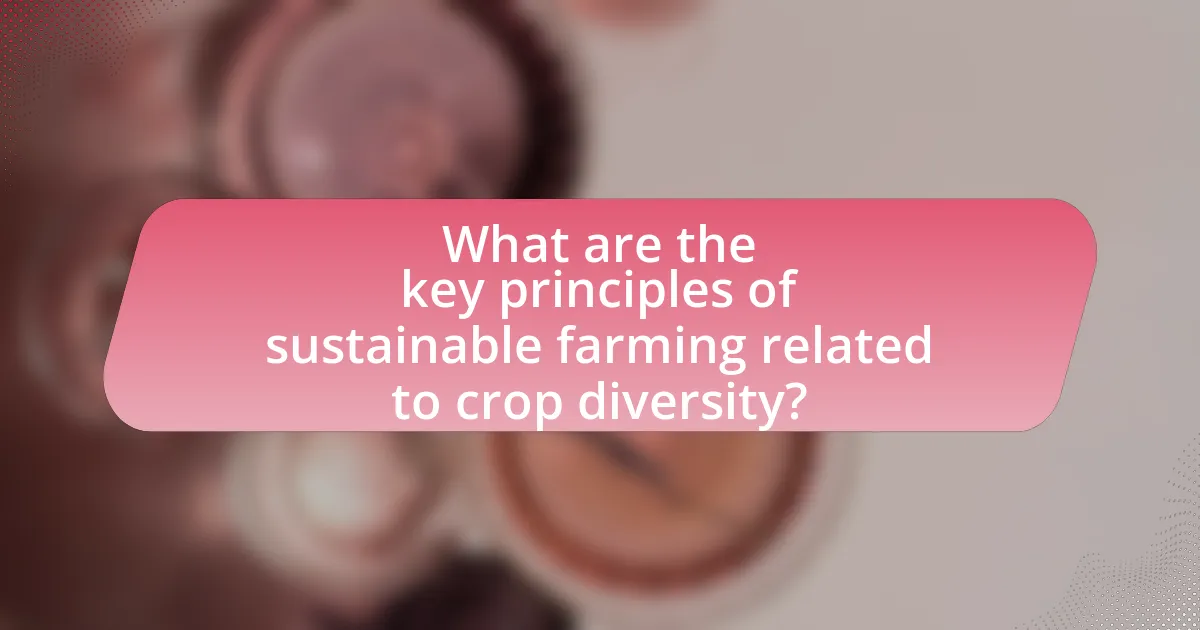
What are the key principles of sustainable farming related to crop diversity?
The key principles of sustainable farming related to crop diversity include promoting biodiversity, enhancing ecosystem resilience, and improving soil health. Promoting biodiversity involves cultivating a variety of crops to reduce dependency on single species, which mitigates risks associated with pests and diseases. Enhancing ecosystem resilience is achieved through diverse cropping systems that can better withstand environmental stresses, such as climate change and extreme weather events. Improving soil health is facilitated by crop rotation and intercropping, which contribute to nutrient cycling and reduce soil erosion. Research indicates that farms with higher crop diversity can yield more stable production over time, supporting food security and sustainability.
How does crop rotation enhance sustainability?
Crop rotation enhances sustainability by improving soil health, reducing pest and disease pressure, and increasing biodiversity. By alternating different crops in a specific sequence, soil nutrients are replenished, as different plants have varying nutrient requirements and contributions. For instance, legumes can fix nitrogen in the soil, benefiting subsequent crops. Research indicates that crop rotation can lead to a 10-20% increase in crop yields compared to monoculture systems, as demonstrated in studies conducted by the USDA. Additionally, rotating crops disrupts the life cycles of pests and diseases, leading to lower reliance on chemical pesticides, which further supports environmental health.
What are the best practices for implementing crop rotation?
The best practices for implementing crop rotation include selecting diverse crops, planning rotations based on crop families, and incorporating cover crops. Diverse crops help break pest and disease cycles, while planning rotations according to crop families minimizes nutrient depletion and enhances soil health. Incorporating cover crops, such as legumes, improves soil structure and adds organic matter, further promoting sustainability. Research indicates that farms practicing effective crop rotation can increase yields by 10-20% compared to monoculture systems, demonstrating the tangible benefits of these practices.
How does crop rotation affect yield and soil quality?
Crop rotation positively affects yield and soil quality by enhancing nutrient availability and reducing pest and disease pressure. By alternating different crops, farmers can improve soil structure and fertility, as diverse root systems contribute to better nutrient uptake and organic matter content. Research indicates that crop rotation can increase yields by 10-25% compared to continuous cropping systems, as demonstrated in studies conducted by the USDA Agricultural Research Service. Additionally, rotating crops helps break pest and disease cycles, leading to healthier plants and reduced reliance on chemical inputs.
What is the role of indigenous crops in sustainable farming?
Indigenous crops play a crucial role in sustainable farming by enhancing biodiversity, improving soil health, and promoting resilience against climate change. These crops are often well-adapted to local conditions, requiring fewer inputs such as water and fertilizers, which reduces environmental impact. Research indicates that indigenous crops can yield higher nutritional value and support local ecosystems, as they often coexist with native species, fostering a balanced agricultural environment. For instance, studies have shown that incorporating indigenous varieties can lead to increased crop resilience, with some varieties demonstrating resistance to pests and diseases, thereby reducing the need for chemical interventions.
How can indigenous crops improve local biodiversity?
Indigenous crops can improve local biodiversity by enhancing ecosystem resilience and supporting a wider range of species. These crops are often well-adapted to local environmental conditions, which allows them to thrive without the need for chemical inputs, thus promoting healthier soil and water systems. For instance, studies have shown that regions cultivating indigenous crops experience increased populations of beneficial insects and microorganisms, which contribute to pollination and soil fertility. Additionally, indigenous crops can provide habitats and food sources for local wildlife, further enriching the ecosystem. This relationship between indigenous crops and biodiversity is supported by research indicating that diverse agricultural systems can lead to improved ecosystem services and greater overall biodiversity.
What are the economic benefits of cultivating indigenous crops?
Cultivating indigenous crops provides significant economic benefits, including increased resilience to climate change and reduced dependency on external inputs. Indigenous crops are often well-adapted to local conditions, which can lead to higher yields and lower production costs. For instance, a study by the Food and Agriculture Organization (FAO) highlights that indigenous crops can enhance food security and generate income for local farmers by tapping into niche markets that value traditional and organic produce. Additionally, these crops often require fewer chemical inputs, which can lower costs and improve profit margins for farmers.
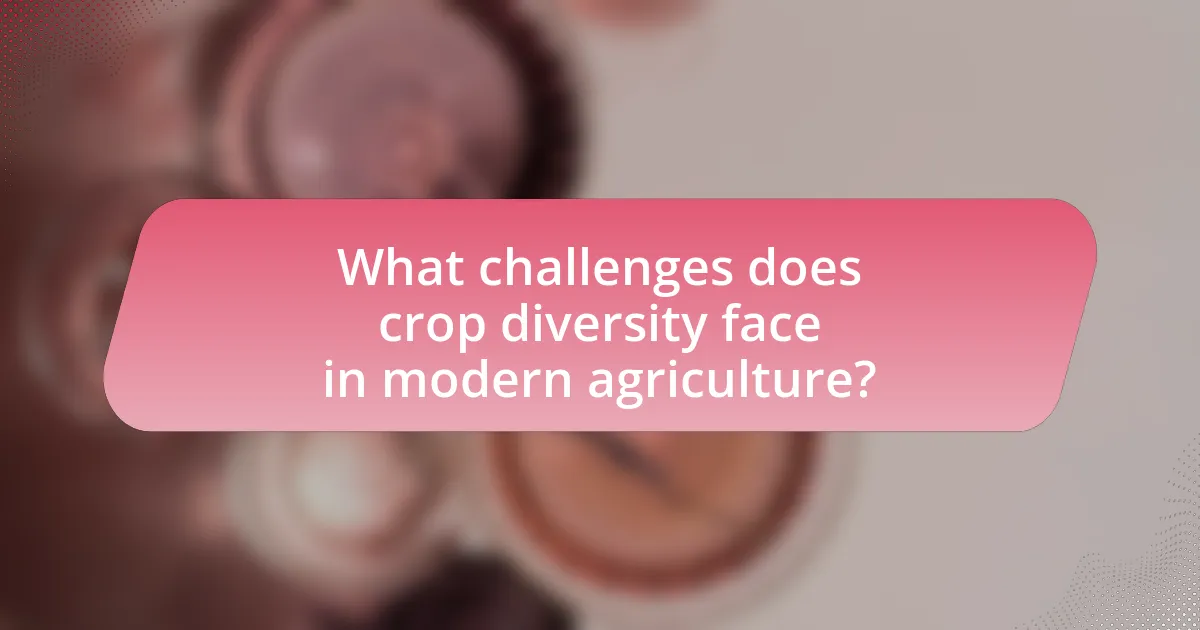
What challenges does crop diversity face in modern agriculture?
Crop diversity in modern agriculture faces significant challenges, primarily due to industrial farming practices that prioritize monocultures. Monocultures reduce genetic variation, making crops more susceptible to pests and diseases, which can lead to crop failures. For instance, the Green Revolution emphasized high-yield varieties, which often resulted in the neglect of traditional crop varieties, diminishing overall biodiversity. Additionally, climate change poses a threat by altering growing conditions, further endangering diverse crop species. According to the Food and Agriculture Organization, approximately 75% of global food diversity has been lost since the 1900s, highlighting the urgent need to address these challenges to ensure sustainable agricultural practices.
How do monocultures threaten crop diversity?
Monocultures threaten crop diversity by promoting the cultivation of a single crop species over large areas, which reduces genetic variation and increases vulnerability to pests and diseases. This lack of diversity can lead to widespread crop failures, as seen in the Irish Potato Famine of the 1840s, where reliance on a single potato variety resulted in catastrophic losses due to blight. Furthermore, monocultures disrupt ecosystems, diminishing the presence of beneficial organisms that contribute to soil health and pest control, ultimately undermining agricultural resilience and sustainability.
What are the long-term effects of monoculture practices?
The long-term effects of monoculture practices include soil degradation, increased pest and disease susceptibility, and reduced biodiversity. Monoculture, the agricultural practice of growing a single crop species over a wide area for consecutive seasons, leads to nutrient depletion in the soil as the same crop extracts specific nutrients repeatedly. This can result in diminished soil fertility, requiring increased chemical fertilizers, which can further harm soil health over time. Additionally, monoculture creates an environment conducive to pests and diseases that target the specific crop, leading to higher pesticide use and potential resistance issues. Studies have shown that diverse cropping systems can enhance ecosystem resilience, improve soil health, and reduce the need for chemical inputs, highlighting the importance of crop diversity in sustainable farming practices.
How can farmers transition from monoculture to diverse cropping systems?
Farmers can transition from monoculture to diverse cropping systems by implementing crop rotation, intercropping, and agroforestry practices. Crop rotation involves alternating different crops in the same field across seasons, which enhances soil health and reduces pest and disease cycles. Intercropping, the practice of growing two or more crops in proximity, can improve biodiversity and resource use efficiency. Agroforestry integrates trees and shrubs into crop systems, providing additional benefits such as improved soil structure and microclimate regulation. Research indicates that diverse cropping systems can lead to increased resilience against climate change and improved yields; for instance, a study published in “Nature” by Tilman et al. (2017) found that biodiversity in cropping systems can enhance productivity by up to 20%.
What are the barriers to adopting crop diversity in farming?
The barriers to adopting crop diversity in farming include economic constraints, lack of knowledge, and institutional challenges. Economic constraints arise from the initial costs associated with diversifying crops, which can deter farmers who are already facing financial pressures. Lack of knowledge pertains to insufficient information or training on the benefits and practices of crop diversity, leading to reluctance in changing established farming methods. Institutional challenges involve inadequate support from agricultural policies and programs that often favor monoculture practices, making it difficult for farmers to transition to diverse cropping systems. These barriers collectively hinder the widespread adoption of crop diversity, which is essential for sustainable farming practices.
How can policy changes support crop diversity initiatives?
Policy changes can support crop diversity initiatives by providing financial incentives and regulatory frameworks that encourage the cultivation of a wider variety of crops. For instance, governments can implement subsidies for farmers who grow diverse crops, which can reduce the economic risks associated with monoculture practices. Additionally, policies that promote research and development in crop breeding can lead to the introduction of resilient and diverse crop varieties. Evidence from the Food and Agriculture Organization indicates that countries with supportive agricultural policies see a 20% increase in crop diversity, enhancing food security and ecosystem resilience.
What role do farmers’ cooperatives play in promoting crop diversity?
Farmers’ cooperatives play a crucial role in promoting crop diversity by facilitating collective action among farmers to share resources, knowledge, and access to diverse seed varieties. These cooperatives enable farmers to collaborate on sustainable practices, which enhances the cultivation of a wider range of crops, thereby increasing biodiversity. Research indicates that cooperatives can improve farmers’ resilience to climate change and market fluctuations by diversifying their crop production, as evidenced by a study published in the Journal of Agricultural Economics, which found that cooperative membership significantly correlates with increased crop variety and reduced risk for farmers.
What practical steps can farmers take to enhance crop diversity?
Farmers can enhance crop diversity by implementing crop rotation, intercropping, and selecting diverse seed varieties. Crop rotation involves alternating different crops in the same field across seasons, which helps improve soil health and disrupt pest cycles. Intercropping, or planting multiple crops in proximity, can increase biodiversity and reduce the risk of total crop failure due to pests or diseases. Additionally, selecting diverse seed varieties allows farmers to adapt to changing climate conditions and market demands, thereby increasing resilience. Research indicates that farms practicing these methods can see improved yields and reduced reliance on chemical inputs, supporting sustainable farming practices.
How can farmers select diverse crops for their specific regions?
Farmers can select diverse crops for their specific regions by assessing local climate, soil conditions, and market demand. Understanding the microclimate and soil type allows farmers to choose crops that are well-suited to their environment, enhancing growth potential and yield. For instance, a study by the Food and Agriculture Organization (FAO) highlights that crop diversity can improve resilience against pests and diseases, which is crucial for sustainable farming practices. Additionally, farmers can consult local agricultural extension services for recommendations on crop varieties that thrive in their specific conditions, ensuring that their selections are both ecologically viable and economically beneficial.
What resources are available for farmers to learn about crop diversity?
Farmers can access various resources to learn about crop diversity, including agricultural extension services, online platforms, and educational workshops. Agricultural extension services provide localized information and support, often through government or university programs, which help farmers understand the benefits and practices of crop diversity. Online platforms such as the Food and Agriculture Organization (FAO) and the International Center for Tropical Agriculture (CIAT) offer research articles, guides, and databases focused on crop diversity. Additionally, educational workshops and field days organized by agricultural organizations and universities facilitate hands-on learning and networking opportunities for farmers to explore diverse cropping systems.

